Note: This website was automatically translated, so some terms or nuances may not be completely accurate.
Japan's Cashless Progress—Yet Cash Usage Remains High: The Puzzle
"The COVID-19 pandemic must have expanded consumers' cashless usage and accelerated cashless acceptance at stores. Especially contactless payments, being hygienically safe, should have seen remarkable progress."
Based on this hypothesis, Dentsu Inc. Cashless Project conducted the second "Survey on Cashless Awareness Among Consumers During the COVID-19 Pandemic" ( survey overview here ) in December 2021.
The purpose of this survey was to clarify how consumers' payment methods have changed amid significant lifestyle shifts due to COVID-19 and to identify which payment methods will become mainstream going forward. This was the second survey, following the first conducted in December 2020.
The results spectacularly overturned optimistic assumptions. While cashless usage among consumers is indeed increasing, stubborn barriers hindering cashless adoption have also become apparent. This series will unravel these findings.
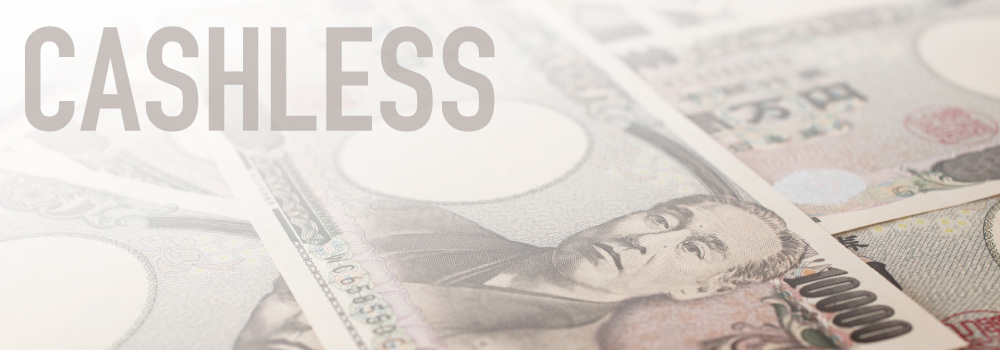
<Table of Contents>
▼Only 6.7% of adults do not use cashless payments
▼60% increased cashless payment ratio after state of emergency declaration
▼Cashless use grows in places closely tied to daily life
▼Hospitals and clinics are places where cashless unavailability causes trouble
▼Why not use it? The mystery of high cash usage even in places where cashless use increased
▼Small-amount cashless payments hold future growth potential
▼Japanese people show low hygienic resistance to cash
▼Two essential factors for promoting cashless among consumers
Only 6.7% of adults do not use cashless payments
What percentage of Japanese adults use cashless payments? We surveyed 500 men and women aged 20 to 69 online.
The results showed that 93.3% were cashless users. In the previous survey (December 2020), the figure was 88.6%. This represents a 4.7% increase over the past year. Non-users, meaning those who only use cash, decreased from 11.4% to 6.7%.
93.Seeing that 3% of people are cashless users, some might reflect on how far Japan has come in cashless adoption.
Indeed, among cashless users, the proportion of those who "use it frequently" has increased over the past year. It was 43.5% in 2020 but rose to 56.2% in 2021, a 12.7% increase. This is welcome news for cashless advocates.
However, 14.4% still answered they "use it only a little." For these people, cash remains the primary payment method for the majority of their transactions. While 22.7% answered they "use it," it's likely these people use both cashless and cash. It's possible cash might even be their primary method.
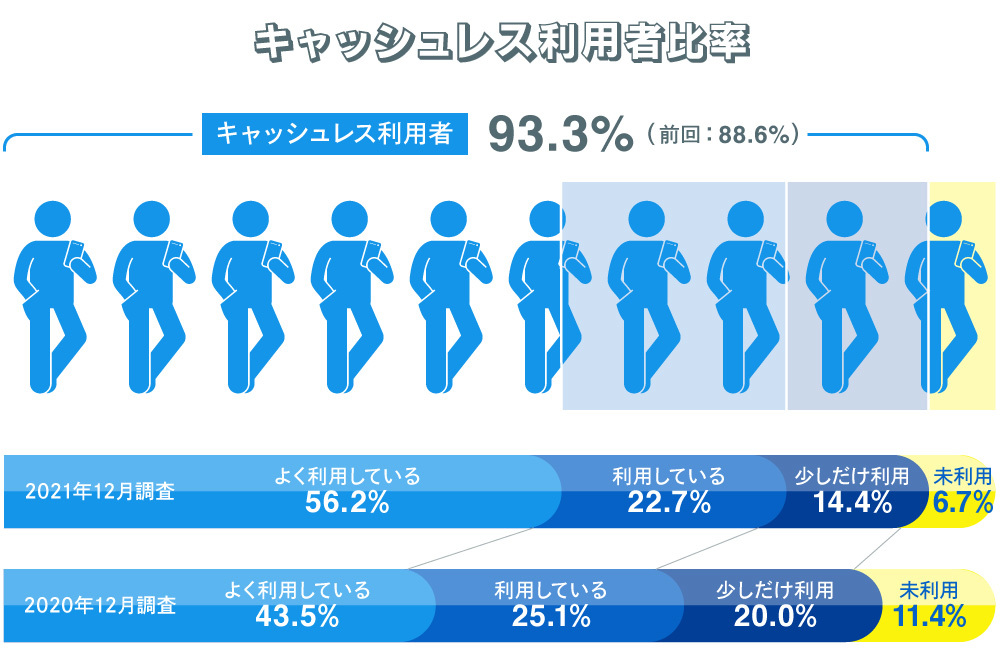
Since the state of emergency declaration, 60% increased their cashless payment ratio
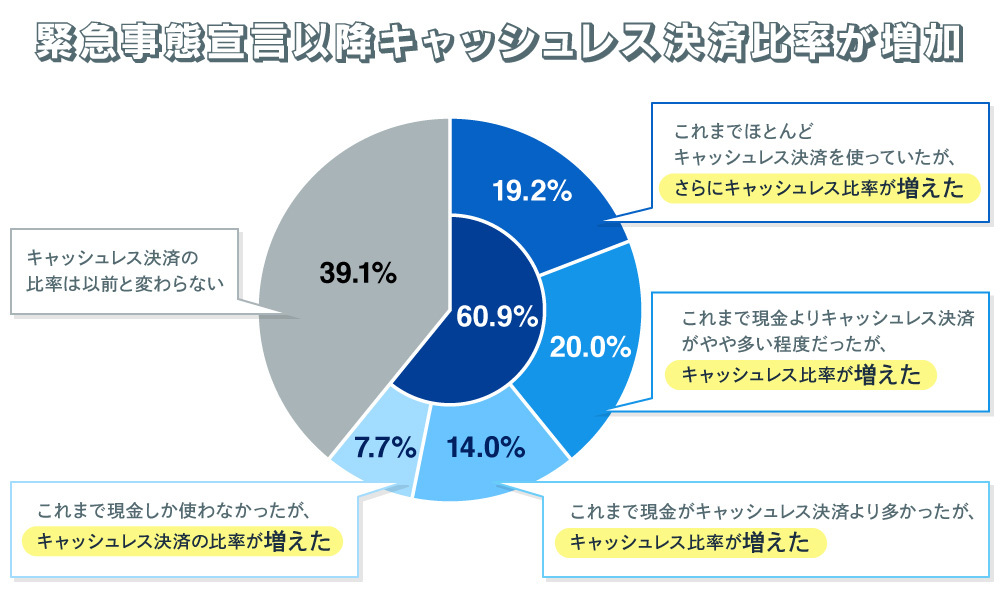
There was another piece of welcome news for cashless advocates. Since the April 2020 state of emergency declaration, 60.9% of respondents reported an increase in their cashless payment ratio. This means two out of three people increased their cashless payments compared to before the declaration, suggesting the pandemic accelerated the cashless trend.
Breaking this down: 19.2% of respondents stated, "I already used cashless payments quite a bit, but my cashless ratio increased further." Meanwhile, 20.0% said, "I used cashless payments slightly more than cash before, but my cashless ratio increased."
Combined, these two groups total 39.2%. This means 64.0% of those who increased cashless payments were already primary cashless users. People already using cashless payments understand their convenience. Habits are easier to increase in frequency.
On the other hand, 14.0% of respondents stated, "I previously used cash more than cashless payments, but my cashless ratio has increased." 7.7% stated, "I previously only used cash, but my cashless payment ratio has increased." Combined, 21.7% of people are gradually shifting from cash-only to cashless. The fact that the pandemic managed to convert people who were attached to cash usage to cashless users in just two years can be seen as a positive impact of the pandemic.
Cashless usage is increasing in places closely tied to daily life
So where exactly did cashless payments increase? To pinpoint the locations, we asked 467 cashless users (multiple answers allowed) where they used cashless payments more.
The location where the most people increased their usage was convenience stores. With approximately 57,000 stores nationwide, convenience stores are an integral part of daily life. The average transaction amount per visit is said to be around 500 yen. This means 40.6% of people are using cashless more often for low-value purchases.
Second place was supermarkets and shopping malls at 38.5%. Supermarkets handle essential groceries and daily necessities. It seems people are also increasing their cashless usage without hesitation for buying food and household items.
Drugstores ranked third. There are approximately 22,000 drugstores nationwide in Japan. The average transaction amount is said to be around ¥1,000. Like convenience stores, they are deeply integrated into daily life. The number of people who increased their usage at drugstores was 32.6%.
Fourth place was online shopping at 23.6%. While we assumed this would see a significant increase due to the COVID-19 pandemic, since online shopping is already cashless, people likely don't feel like they're using it more often. Overall, the top three places where cashless usage increased are deeply connected to daily life.
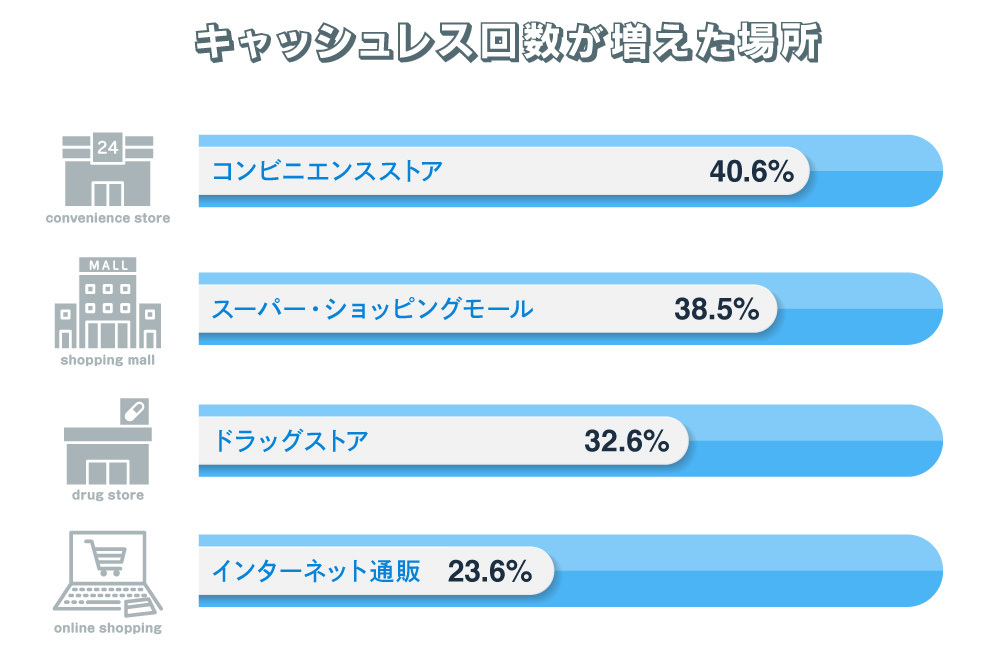
Places where people struggle because cashless isn't accepted: Hospitals and clinics
We often hear the sentiment that "cashless isn't progressing because there are stores that don't accept it." Therefore, this survey also asked respondents to identify specific places where they wanted to use cashless but couldn't.
The location where people most frequently reported difficulty due to lack of cashless options was hospitals and clinics. 33.3% of cashless users responded this way. While large hospitals accept cashless payments, many smaller and medium-sized facilities still do not offer this option.
During the COVID-19 pandemic, people naturally want to use cashless payments as much as possible at hospitals and clinics. Yet, they often cannot. This highlights an area where Japan lags behind Europe and the US.
Second place was small and medium-sized stores at 14.3%, followed by shopping districts at 13.9%. These two locations have long been known for having many places where cashless payments are unavailable. Fourth place was hair salons and nail salons at 11.6%. Considering hygiene, promoting cashless payments might be desirable in these settings.
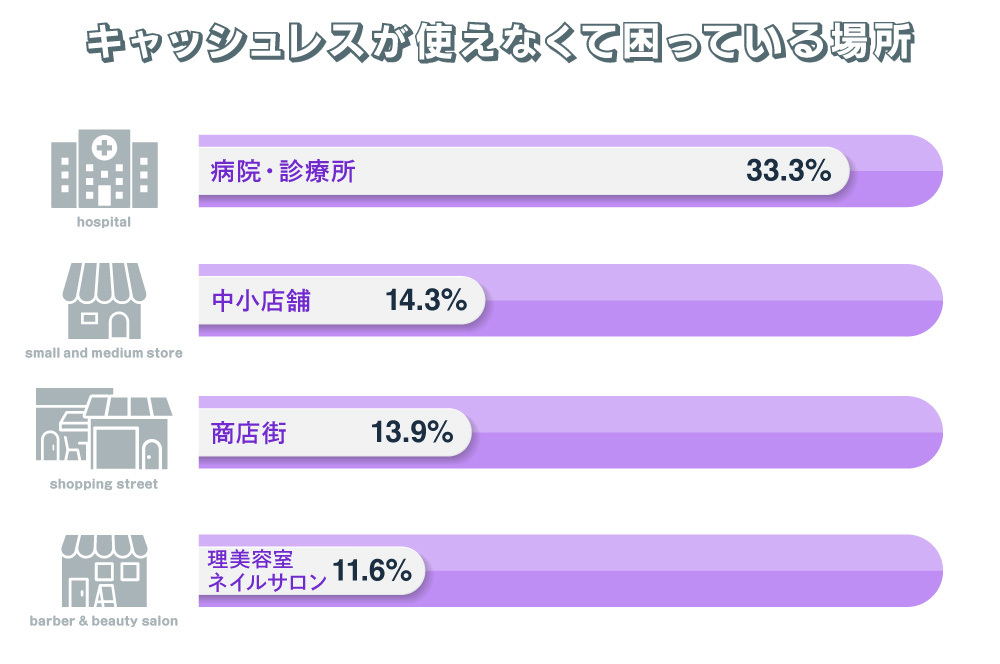
Why Not Use It? The Mystery of High Cash Usage Even in Places Where Cashless Use Has Increased

The top 3 places where cashless transactions increased were convenience stores (40.6%), supermarkets/shopping malls (38.5%), and drugstores (32.6%). You'd think cash payments would be rare in these places, with most transactions likely being cashless. However, the survey results were unexpected.
The most commonly used payment method at convenience stores was mobile payments (51.7%). So what came in second?
Surprisingly, it wasn't cards (25.9%) or e-money (27.9%), but cash (46.9%).
At supermarkets and shopping malls, cards (56.4%) took the top spot, followed by cash (54.7%). Surprisingly, at drugstores, cash (49.2%) was the most popular method.
93.Despite 3% of respondents reporting they have cashless payment methods, and cash still being used this much in the top three locations where cashless usage increased after the state of emergency declaration, why is cash still used so much?
There are hardly any places in these locations where cashless payments aren't possible. So why do people still use cash?
Small-amount cashless payments represent future growth potential
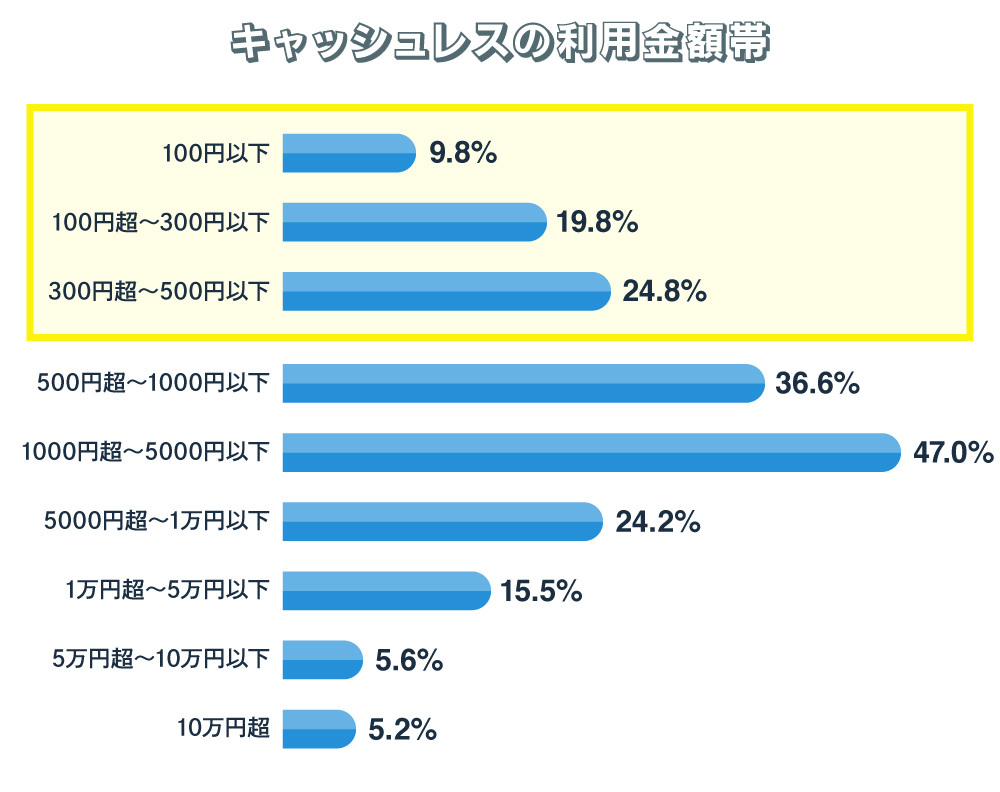
In reality, at convenience stores, supermarkets, drugstores, and department store registers, it seems many people pay with cash even though they have cards in their wallets. You almost feel like saying, "You can use your card."
Why do they use cash? One reason is shown in the chart above: cashless usage is low for small transactions. For amounts over ¥300 but under ¥500, cashless use is less than one in four people. For amounts under ¥100, it's less than one in ten. The average transaction amount per customer at convenience stores is about ¥500. Cashless usage drops significantly for amounts below that.
Globally, cashless payments are already commonplace in these three everyday retail sectors. In Sweden, you might get a frown if you pull out cash. Shops want to speed up checkout with cashless payments and dislike the potential for errors in handling coins.
Similarly in Japan, retailers in these three sectors should also seek the efficiency of cashless payments. So what lies behind these results?
Is there anxiety that using cashless for small payments might lead to being told "we don't accept it"? Or is there a sense of "apologetic" about incurring merchant fees for small transactions? Yet people use cashless without hesitation for small payments on public transport. "It's perfectly fine to pay cashless casually, regardless of the purchase amount." Perhaps awareness of this among consumers is still insufficient.
Japanese people have low hygienic resistance to cash
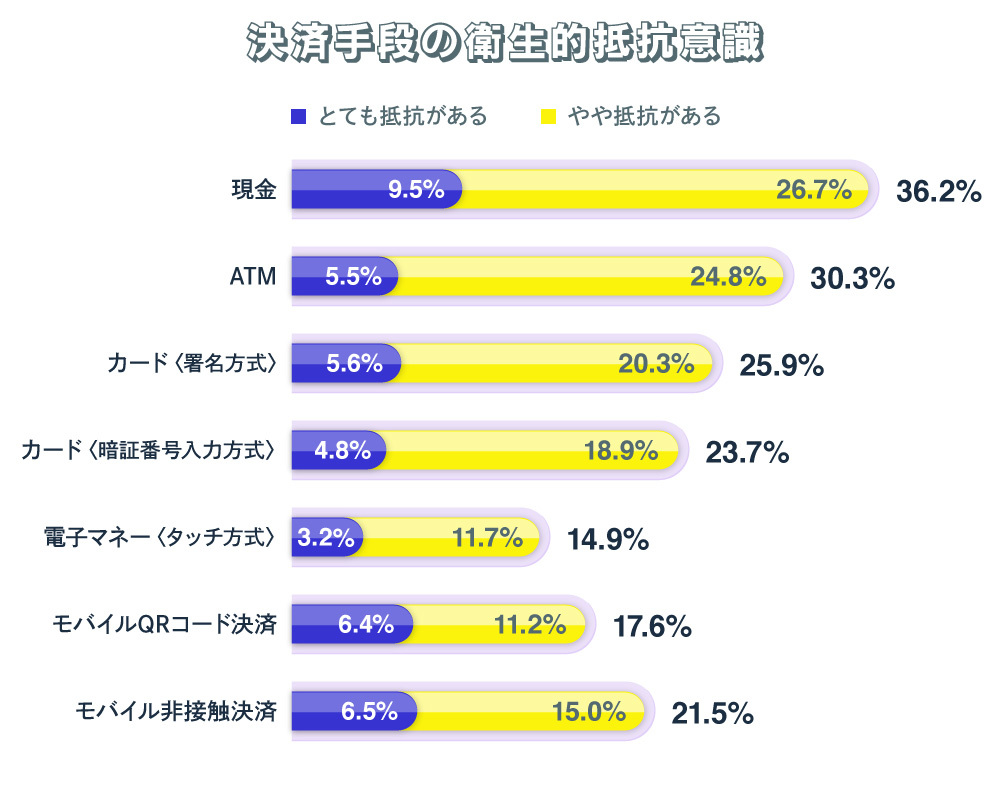
Another reason cashless adoption lags is the low level of hygienic resistance Japanese people feel toward cash. The COVID-19 pandemic has made cleanliness more important than ever. Hygiene concerns have also surfaced regarding payment methods. Given this situation, we asked which payment methods people feel hygienic resistance toward. Cash topped the list of "Strong Resistance" at 9.5%. However, this represents less than one-tenth of consumers. This was the case even though the question deliberately included the preface: "Cleanliness has become more important due to the novel coronavirus."
Adding those who feel "some resistance," the total feeling hygienic resistance toward cash reaches 36.2%. Even so, this remains only about one in three people. While many hesitate to hold onto straps, few feel that resistance toward cash itself. In Europe and the US, considering the safety of consumers and employees, cashless payments are already becoming commonplace. Awareness among consumers about the benefits and safety of cashless payments has not kept pace. This is a major challenge.
Two Essential Factors for Promoting Cashless Among Consumers
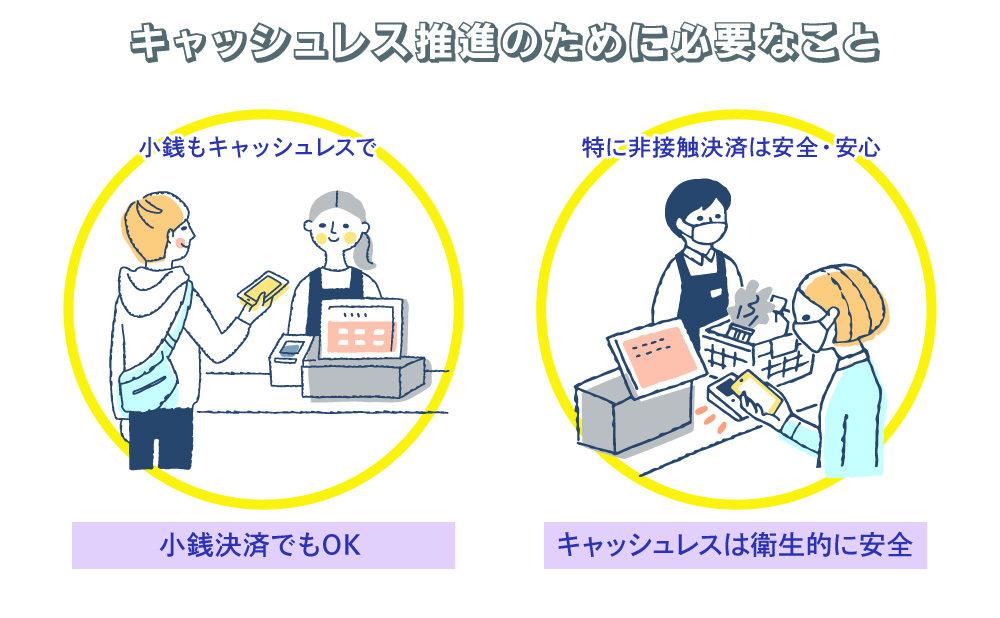
This survey on consumer attitudes toward cashless payments identified key hurdles to overcome for its promotion: the low cashless payment ratio for small transactions and low awareness of the benefits of cashless payments.
Cashless users now account for 93.3% of the population. After the state of emergency declaration, 60.9% of people increased their cashless usage. The top three places where cashless usage increased were convenience stores, supermarkets/shopping malls, and drugstores. However, cash usage rates in these locations remained high. Behind this, a barrier became apparent: the slow adoption of cashless payments for small transactions under 500 yen.
There is absolutely no need to feel awkward about using cashless payments at stores. After all, the stores themselves prefer cashless payments. Furthermore, a significant issue is the low awareness of the benefits of cashless payments. Despite being a cleanliness-conscious nation, Japanese people show little resistance to cash. It has become clear that there is a need to repeatedly communicate the benefits of cashless payments to consumers.
Next time, we'll explore contactless payments, the driving force behind Japan's cashless movement, and unravel their potential for advancing cashless payments going forward.
[Survey Overview]
Title: 2nd Survey on Cashless Awareness Among Consumers During the COVID-19 Pandemic
Survey Method: Internet survey
Survey Period: December 16-17, 2021
Survey Area: Nationwide
Survey Participants: 500 men and women aged 20–69 (weighted based on population composition)
Survey Sponsor: Dentsu Inc. Dentsu Cashless Project
Survey Company: Dentsu Macromill Insight, Inc.
Was this article helpful?
Newsletter registration is here
We select and publish important news every day
For inquiries about this article
Author

Yoshitomi Sairyo
Dentsu Inc.
BX Creative Center, Experience Design Department
Senior Planning Director
Head of the Dentsu Cashless Project. Joined Dentsu Inc. after working at a U.S.-based consulting firm and a European investment bank. Engaged in new business development, marketing and brand strategy, and PR for clients in finance (banks, securities, insurance, etc.), telecommunications, automotive, beverages, toiletries, and pharmaceuticals. Contributions include "Corporate Reputation" (Advertising) and "CSR and Corporate Reputation" (Nikkei Branding). Certified Member of the Securities Analysts Association of Japan.


